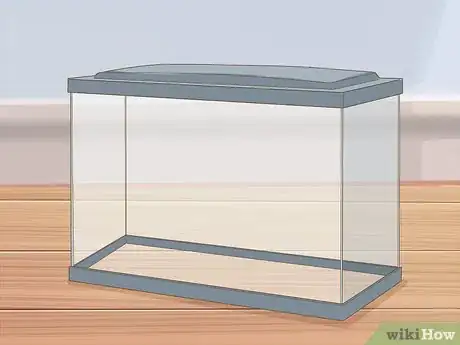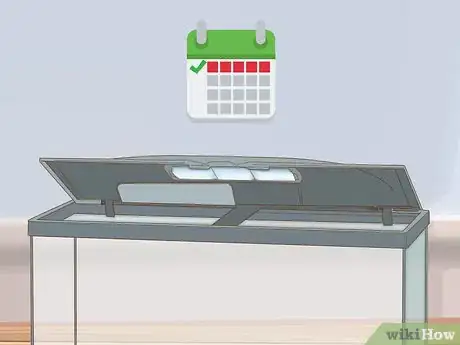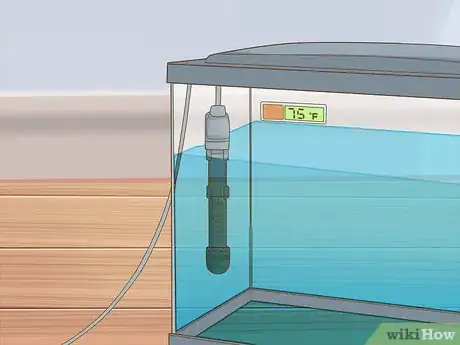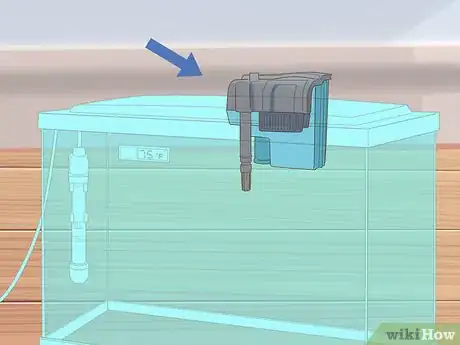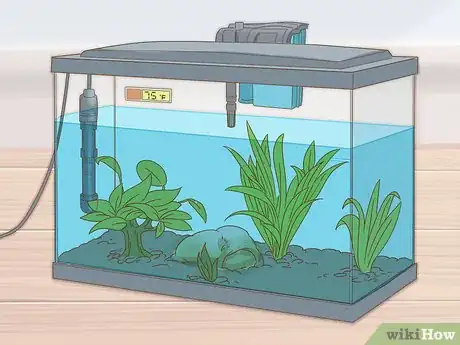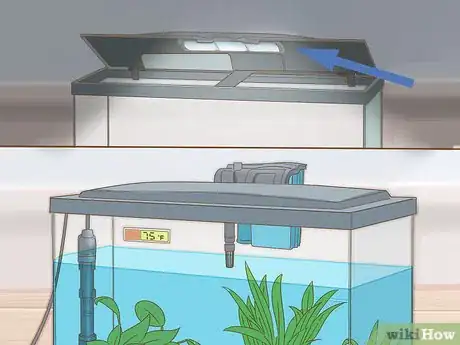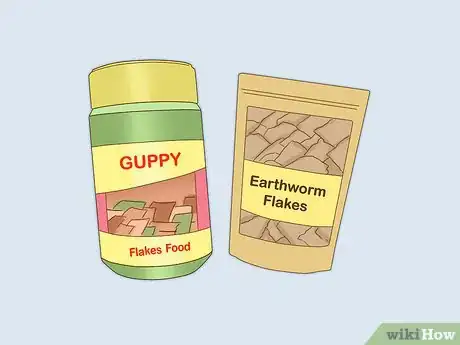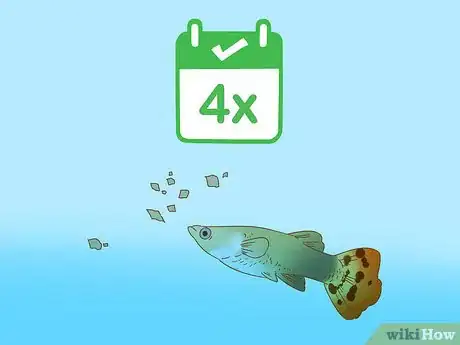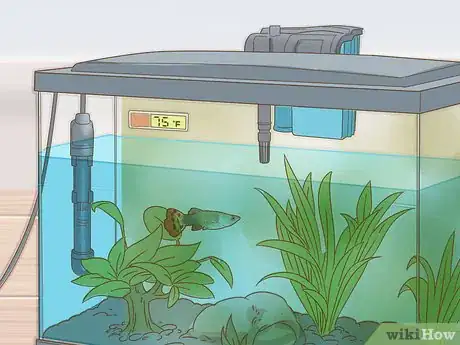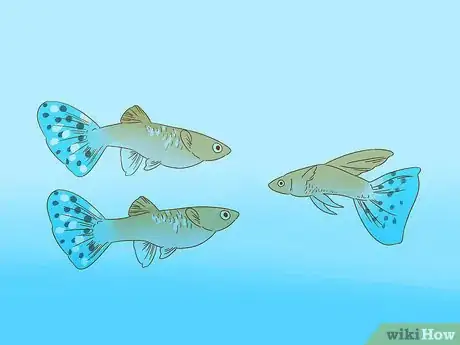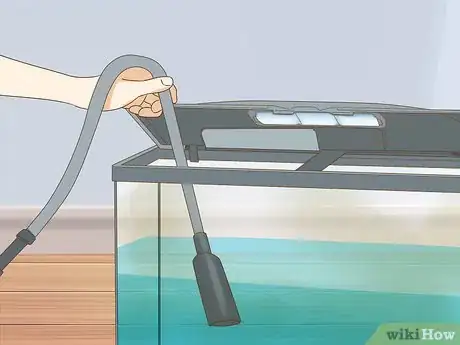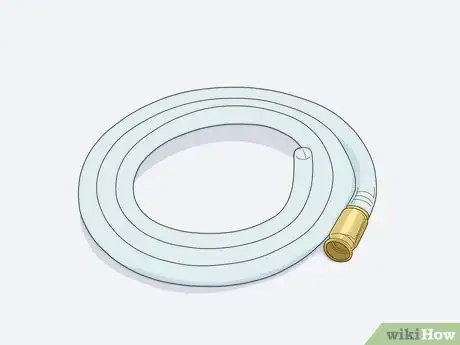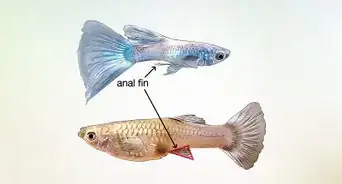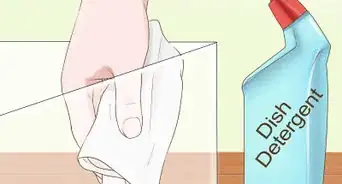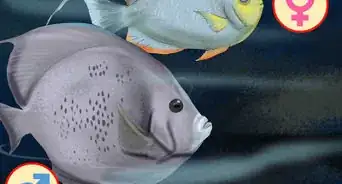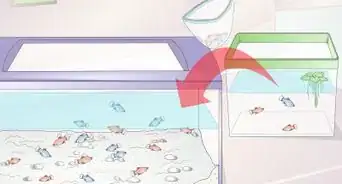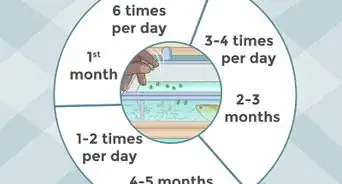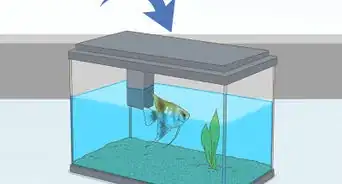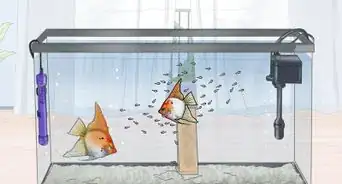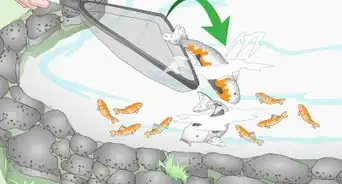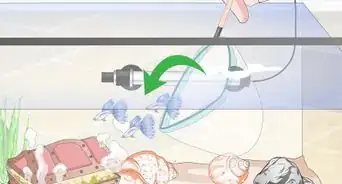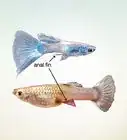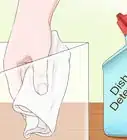This article was co-authored by Marshall Stephens. Marshall Stephens is an Aquarium Expert at Private Oceans Aquariums in West Palm Beach, Florida. Marshall has over 20 years of experience in the aquarium industry and focuses on captive-bred animals. They specialize in tropical and marine aquariums and are a contributor to the Loggerhead Marine life center in Jupiter Florida.
There are 7 references cited in this article, which can be found at the bottom of the page.
wikiHow marks an article as reader-approved once it receives enough positive feedback. This article has 26 testimonials from our readers, earning it our reader-approved status.
This article has been viewed 832,255 times.
Guppies are one of the most colorful tropical freshwater fish in the world. They are small and relatively easy and inexpensive to take care of. They are a great fish to start with when beginning to build an aquarium, or learning to care for fish. With a properly outfitted aquarium, proper feeding, and careful handling, these fish can thrive.
Steps
Setting Up a Habitat
-
1Choose an aquarium tank. Ideally, your tank will be 10 gallons (37.9 L) in volume. You don’t want to overcrowd your tank. If you have a 10-gallon tank, for example, aim for about five guppies. This will simply help you maintain the tank better and keep your fish healthier.
- Some guppy breeders and enthusiasts might argue that you don’t need to follow that ratio, but the more fish you have in your tank, the more often you will have to clean it and change the water. Consider this when deciding what size tank to get, and how many guppies to keep in it.
-
2Dechlorinate the water in the tank. There are a few ways you can dechlorinate your water. You can let it sit with the lid open for about a week to let the chlorine evaporate, or you can buy a dechlorinating kit. It’s important to dechlorinate your aquarium, and any water you add to it in the future.[1]
- You can buy these supplies at a local pet supply store for a relatively low cost. You will also want to buy a chlorine testing kit, just to make sure the water is completely free of chlorine before adding your fish. Follow instructions on the dechlorination bottle.
- Nearly all tap water has a certain level of chlorine in it. You can use purified, filtered, or distilled water that is free of chlorine, to begin with, but to be safe, still test the water for chlorine before putting your fish in it.[2]
- Try to keep the pH level in your tank between 8/10 guppies like higher level pH so aim for around 7.5pH to help you keep the pH at a high you may want to add crushed coral.
Advertisement -
3Keep the water between 75 and 80 degrees Fahrenheit. This is equal to about 24 and 28 degrees Celsius. Keep a thermometer in the tank to monitor the temperature. If you find it needs to be heated, you can purchase a small heater to place in the tank.
- If you need a heater, make sure you buy one that is appropriate for the size of the aquarium you have. For example, if you have a 5-gallon tank, you’ll need a less powerful heater than if you have a 20-gallon tank. Ask the associate at the pet supply store if you aren’t sure which heater you need.
- To avoid overheating your tank, it’s best to keep it out of direct sunlight. Use a heater if you need to raise the temperature, and use an artificial light in the tank rather than sunlight. If for some reason the water becomes overheated, take some of the warm water out and replace it with cooler water to lower the temperature slowly.
-
4Use a filtration system in your tank. For the most part, aquarium tanks will come equipped with a filtration system. If yours did not, you would need to purchase one separately. You will need to change the filter media when it begins to turn brown, so make sure you monitor this whenever you clean the tank. Ceramic Media is good for beneficial bacteria and will help keep your tank healthy and clean, only replace half your media at a time to make sure you arent taking away all the good bacteria at once.[3]
- Even if your tank did come with a filter, you can always change it out for a different or better one should you feel you need to. Make sure your filtration system can keep up with the amount of fish you have and the size of your tank.
- A regular filtration system should be enough to keep your tank oxygenated, but you can also add an airstone to help add oxygen to the water if you have a larger tank or if you have lots of fish.
- You should keep the tank set up and working for a month without any fish, just avoid the temptation of buying any fish before. The bacteria are in the media part of the filter (where bacteria develop) and clean out the toxic substances that are dissolved in our water, as fish contaminate their own water by excreting. These substances aren't removed by the mechanical system of the filter, only bacteria can transform these highly toxic substances into others much less toxic, that can be removed by changing part of the water weekly. In this month feed the bacteria with some fish food (1 flake each three days), in order to train them for when the fish come. This whole process is called cycling.
-
5Add plants and decorations to your tank. Start from the bottom—add some substrate to the bottom of the tank. Stones or gravel are a great option for guppies. Then, add in plants. You should use live plants, as they take an important part that, along with the bacterias, will help with the toxic substances. The other important thing is that the fish have somewhere to hide, as guppies like to do this.[4]
- Make sure you rinse all substrate and decorations before placing them in the water. You want to make sure you get all the dust or dirt off of them that they may have picked up in the supply store.
- Avoid adding things taken from nature, such as clams, roots, sand, because they might contain parasites or will modify your pH (or the general hardness if adding calcareous stones) This may lead to illnesses in your fish or even their death. It's better if you buy them in your pet store, this way, you avoid unpleasant surprises. Only those who have experience in keeping fish would pick things from nature, as they difference between roots and rocks (making a previous study on them and getting some information in advance) which are innocuous to the water quality and those who are not.
-
6Light your tank. Ideally, your guppies should get about 8 hours of darkness per day. Too much more or less than this could cause deformities as they grow. You can put a light over the tank and set it on a timer to ensure your guppies get the right amount of light per day, or you can turn the light on and off manually each morning and night.[5]
- If you are using natural light, like placing your tank near a window or light source, make sure it doesn’t affect the temperature of the water too much. Make sure your water maintains the proper temperature for your guppies. Doing this might lead to algae problems, so it's better to put artificial light.
Feeding Guppies
-
1Feed your guppies the right food. You can feed your guppies all kinds of food, both dry and wet, and both live and frozen. You can buy pre-made flake food for guppies that will provide them with a balanced diet, but make sure you avoid feeding them solely high-protein food. You want to balance protein with vegetable-based food.
- Brine shrimp, earthworm flakes, dried bloodworm, white worms, and mosquito larvae are all great options for feeding your guppies.
- Flake food with fish meal as a primary ingredient is a great choice. Read the labels before buying your guppy food.
-
2Feed your guppies a small amount 2-4 times per day. Rather than feeding your guppies a large amount all at once, spread their feedings out throughout the day. Try to vary what you give them each feeding. For example, you might give them live brine shrimp during one feeding, and then flake food at the next feeding.[6]
- Be careful not to overfeed your guppies. They should be able to consume the food you give them within two minutes.
-
3Monitor your guppies’ digestive health. The tank water is a good indicator of how well the fish are thriving on their diet. If the water goes cloudy, or if there seems to be a problem with algae in your tank, you might be having some issues with your feeding.
- If your tank goes cloudy, lighten up your feeding by about 20% for a few days and see if that helps the fish readjust and the water to balance itself out again. If this happens it might be due to a peak of toxic substances (ammonia and nitrite) because of skipping the cycling period...
Maintaining Healthy Guppies
-
1Keep two or three female guppies for every one male guppy. You will want to keep multiple guppies in your tank, because they are social fish who enjoy being in groups. Make sure you keep a 2:1 ratio of females to males as males have a tendency to stress out the females and chase them around in the tank. Keeping more females than males should help lessen this issue.[7]
- If you want to avoid breeding, you will want to keep all one gender in your tank. Guppies give birth to live fry rather than laying eggs, so if your guppies breed, you will see their babies right as they are born.
- Learn more about breeding guppies before doing so.
-
2Clean the tank once a week. This will mean changing out about 25% of the water and replacing it with fresh, dechlorinated water. You will also want to use a siphon hose to reach down to the bottom of the tank and vacuum up any leftover food, or algae that might be growing on the bottom of the tank.[8]
- When cleaning, you won’t want to take out all of the water and replace it. By taking out only 25-40% of the water, the fish will be better able to adjust.[9]
- Your filter should be doing most of the heavy lifting on a daily basis, but using a siphon hose (easily purchased at a pet supply store) to clean any algae or food from the bottom of the tank will help keep the tank cleaner, and your fish healthier.
- Clean the glass on the inside of the tank if you notice it’s getting dirty. Use a razor blade to scrape off any grime that might be on the inside of the tank, then use the siphon hose to suck it up. Also, you may want to periodically remove any decorations from the tank and rinse them thoroughly to remove any algae or grime build-up.
-
3Purchase a siphon hose from your pet supply store. You can use these while the fish are still in the tank, but make sure you do so with care. If you’re worried about the fish being harmed during the tank cleaning, you can remove them and put them in a separate container of dechlorinated water while you clean.
-
4Monitor your guppies for illness or disease. While this particular species is pretty healthy, guppies may sometimes develop problems with fungus. This most commonly appears as white spots on their skin called ich. This is easily treatable with some medications you can purchase at your pet supply store.[10]
- Keep your tank clean and well-maintained, and you will likely not have any issues with sickness or disease. If any guppies die, make sure you remove them quickly from the tank. If any guppies do show signs of disease or sickness, quarantine them in a separate tank while they heal so they don’t infect the others.
- Some people recommend that you add a bit of aquarium salt to the water to prevent fungus. If you add any tank mates, make sure they can tolerate this (for example, corydoras cannot). Marine salt and cooking salt are not the same things.
Warnings
- Regularly monitor the pH of the water to keep your guppies healthy.⧼thumbs_response⧽
- Mature females bought at pet stores may have been introduced to males already. They can store the males' genetic material for a year, so even a female-only tank can result in fry.⧼thumbs_response⧽
Expert Interview
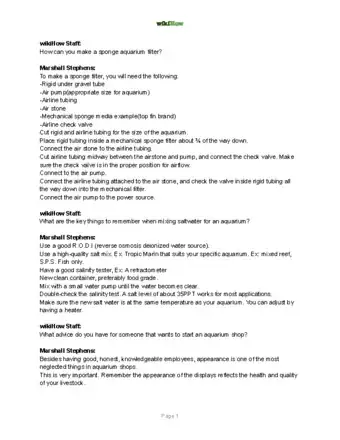
Thanks for reading our article! If you'd like to learn more about taking care of a fish, check out our in-depth interview with Marshall Stephens.
References
- ↑ http://www.firsttankguide.net/dechlorinator.php
- ↑ http://www.drinkmorewater.com/types-of-water
- ↑ http://guppyaquarium.com/guppy-fish-care-guide/
- ↑ https://pethelpful.com/fish-aquariums/Decorating-Your-Fish-Tank-Dos-and-Donts
- ↑ http://guppyaquarium.com/guppy-fish-care-guide/
- ↑ http://guppyaquarium.com/guppy-fish-care-guide/
- ↑ http://guppyfishcare.com/guppy-male-to-female-ratio/
- ↑ http://guppyaquarium.com/guppy-fish-care-guide/
- ↑ http://guppy-fish.com/how-to-clean-tank/
About This Article
To care for your guppies, feed them a balanced diet using pre-made flake food from a pet store. When you give them their flake food, give them as much as they can finish eating in 2 minutes and no more than that. Spread these feedings out so you're feeding your guppies 2-4 times every day. On top of feeding your guppies a balanced diet, you'll want to clean their tank once a week by changing out 25 percent of the water. To learn how to set up the perfect tank for your guppies, keep reading!
